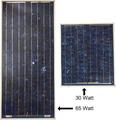
Low Power Solar Panel System
This solar panel system uses three Suntech STP020S (20W) Monocrystalline Silicon solar panels mounted in a triangle to take advantage of the 24 hours a day solar insolation. With the combination of cold temperature and solar reflection off the snow, this system produces close to 40W worth of solar power all day long in clear conditions. This is more than adequate for most seismic recorder configurations.
This solar panel system is also very simple and quick to install in snow. All that is needed is to have the base of the solar system buried in two feet or more of well compacted snow. No guying is necessary. Only one solar cable is needed to connect to a junction box located on the post.





